Gold glass
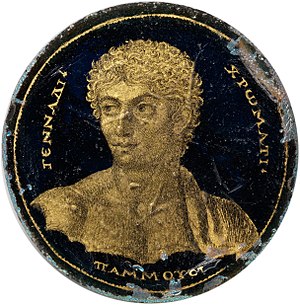
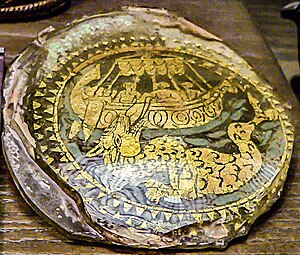
Gold glass or gold sandwich glass is a luxury form of
Various different techniques may sometimes also be described as "gold glass".
Technique
The manufacturing process for gold glass was difficult and required great skill. For a Late Roman glass, first a small round flat disc, typically about three to five inches across, was cut away from a
The larger
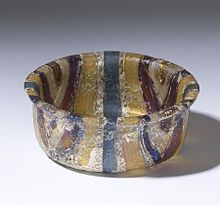
Apart from roundels with figurative images the fused sandwich technique was used to create the
Roman gold glass beads were made by using an inner tube or rod to which the gold leaf was stuck. A larger tube was slid over that and the beads crimped off. Easily transported and very attractive, Roman gold glass beads have been found as far outside the Empire as the Wari-Bateshwar ruins in Bangladesh, and sites in China, Korea, Thailand and Malaysia.[10]
Gold-band glass is a related Hellenistic and Roman technique, where strips of gold leaf, sandwiched between colourless glass, are used as part of the marbling effect in onyx glass. It is mostly found in small perfume bottles and the like.[11]
Grave-markers

The most common form of vessel in late Roman examples was a bowl or drinking cup, which are thought to have been originally family gifts for weddings, anniversaries, New Year, the various religious festivals and the like, in some cases perhaps presented at birth or Christian baptism.
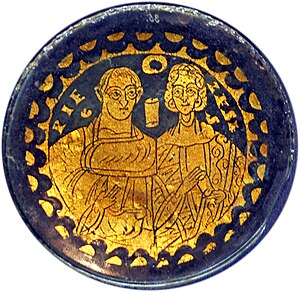
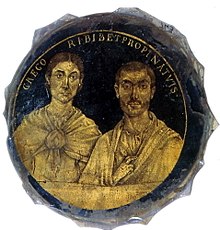
At what was probably a much later date, perhaps after decades of use, on the death of the owner the main vessel of undecorated glass was cut away and trimmed to leave only the gold glass roundel, which was then used in the catacombs as a grave marker. Presumably in many cases the cup had already broken in the normal course of use, and the thick bottom with the decoration had been preserved for later use in this way. Bodies were buried in the catacombs in small recesses called loculi, stacked one above another mostly along narrow corridors hollowed out from the soft rock, and no doubt some form of marker was necessary for visitors to locate the right spot. They may also have functioned as a seal on the grave, as they were pressed into the mortar or stucco forming the final surface of the wall of the loculus; other classes of small decorative objects were also used in the same way. They may also have been regarded as capable of warding off evil spirits, especially in the later part of the period, when portraits of saints become most common.[15]
The very untidy trimming of many examples may be explained by this; an example in the Metropolitan Museum of Art is still attached to a chunk of mortar round much of its edge, showing that the mortar overlapped the edge of the glass. Rough edges would mostly have been hidden by the mortar and also provided a firmer key for the mortar to hold the glass in place (as it happens the edges of the New York piece are unusually neatly trimmed).[16]
Many pieces of gold glass had portraits of private individuals, mostly married couples, who may have included the deceased, while others had portraits of religious figures such as saints, or religious symbols. This custom was followed by Christian, Jewish (13 identifiably Jewish examples are known) and pagan Romans. The different sets of imagery, apart from the increased number of private portraits, are typical of the paintings also found in the catacombs and other
Hellenistic period
The technique was used in
These pieces are usually assigned to
Roman period
Gold glass mosaic tesserae begin to be used in domestic mosaics in the 1st century AD, with Rome apparently the first location. They continued to be used throughout the ancient and medieval periods into the modern day. By around 400 gold began to be used as the background colour for Christian religious mosaics, as it was throughout the Byzantine period.[24]
The decorated late Roman pieces are usually assumed to have been made in and around Rome, especially in the case of portraits of residents there, but also in the Rhineland around Cologne and Augusta Treverorum, modern Trier, which was a centre for other luxury glass products like cage cups. Alexandria is still thought to have been a major centre, and from linguistic analysis of the inscriptions it has been suggested that the technique, and perhaps the actual artists and craftsmen, reached Rome and Germany from there. Yet it may just be a coincidence of survival that the other large body of "middle-class" portraiture from the period is the Fayum mummy portraits from Egypt.[25] Apart from the Rhineland finds discussed below, small numbers of cut-off vessel bases have been found in northern Italy and modern Hungary and Croatia.[26]
The Gennadios medallion in New York, illustrated above, is a fine example of an Alexandrian portrait on blue glass, using a rather more complex technique and naturalistic style than most Roman examples, including painting onto the gold to create shading, and with the Greek inscription showing local
It is thought that the tiny detail of pieces such as these can only have been achieved using

An "Alexander plate with hunting scene" in the

Such secular "blessings" are typical, and on roundels made from cups they often urge the owner to drink, even when the iconography is religious. One Jewish example has the usual array of symbols and the inscription "Drink, [so] you may live, Elares". The Wedding at Cana is a popular Christian subject, with one example inscribed "Worthy of your friends, may you live in the peace of God, drink".[40] Another popular phrase is DIGNITAS AMICORUM or "[you are] the honour of your friends".[41] The majority of inscriptions are made up of either names or such conventional expressions, or the two combined. An example inscribed "DIGNITAS AMICORVM PIE ZESES VIVAS" typifies the tendency to pile together the common phrases.[42] The convivial dedications found on so many examples are paralleled by several of the far more luxurious cage cups or diatreta.
One round bottom from a larger bowl found in the catacombs is 10.8 cm across, and now in the
Iconography of the vessel bottoms
Almost all the Roman vessel bottoms have imagery of some sort, and around 240 have legible inscriptions as well. Of these, about half of the total number of gold glasses known,
Either portraits or inscriptions naming private individuals are very common, though other examples have no personalizing aspect and were perhaps just bought from a dealer's stock.[51] Portraits of married couples are at first most common, but saints were more numerous towards the end of the period; the two are also often combined.[52] It is not always possible to distinguish the two confidently, despite tituli inscriptions and a convention of using contemporary dress for owners and a conventional out of date costume for sacred figures, even recent male ones such as Pope Damasus I (r. 366–384). Damasus, exceptionally for a contemporary cleric, appears on at least four glasses, or at least it is thought he is who "DAMAS" refers to.[53]
Saints Peter and Paul together are very common, usually facing each other in profile, but sometimes with other figures. Both were martyred in Rome, and especially popular there;
Narrative scenes from the Old Testament are more common than miracles of Christ, as in the catacomb paintings, and the same "abbreviated representations" of scenes of deliverance feature: the story of Jonah, Daniel in the lions' den, the three youths in the Fiery Furnace.[59] The most common scenes in later Christian art, centred around the liturgical calendar, are very rare. There are really only two non-Christian narrative scenes: one labour of Hercules (two more are shown in "sidewall blobs"), and one of Achilles, but a number of "portrait" figures, as with Christian sacred figures often combined with owners.[60]
There are a small number of "agonistic" or sporting scenes, with wrestlers, boxers, one gladiator, and several racing chariot teams. Several of these, like others seeming to represent victory in a musical or dramatic context, feature palms and crowns and may well have been presented to celebrate victory in these fields in some amateur or professional setting, like the Alexandrian Gennadios portrait. Two identical glasses featuring two boxers with a trainer, all named, suggest that the glasses may sometimes have been ordered in sets; one may speculate that this may have been common.[61] Single examples show Athena presiding over shipbuilders, a pair of personifications of Rome and Constantinople, and female figures representing the monetae or mints, which are often shown on coins. A number have animals that may carry symbolic meaning, or objects such as scrolls or wreaths.[62]
The short inscriptions tend to be similar regardless of the content of the image, with names and the "convivial formulae" described above together or separately predominating. A religious implication (as may be intended in vivas or zeses for example) is relatively rarely explicitly stated.
Jewish glasses
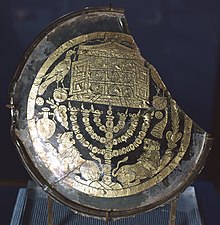

Only 13 of the more than 500 known Late Roman vessel bottoms are identifiably Jewish, but these have still been said to represent "the most appealing group of Jewish realia that have come down from antiquity".
Identifiably Jewish roundels do not feature portraits but with one exception have a fairly standard array of religious symbols. The most common arrangement is on two levels, with two
Most scholars are confident that Jewish customers used the same workshops as those of the other religions, who presumably kept patterns for designs for all religions, or were provided with sketches. Some of the attempts to group glasses by workshop attribute Jewish glasses and those of other religions to the same workshop. Apart from the use of symbols rather than human figures, the Jewish glasses seem to have been used in very much the same way as those from other religious groups, which is also characteristic of other classes of Jewish artefacts from Rome at this time, where the Jewish community adopted many aspects of the general Roman way of life. Of the 13 known, five have inscriptions including the phrase "pie zeses" (see above) and two "anima dulcis" (literally "sweet soul", equating to "sweetheart"), both very common phrases in Christian and pagan inscriptions. The rarer phrase "vivas cum ..." ("live with ...") is also found on Jewish and non-Jewish glasses. They would seem to have been given as gifts on the same sort of occasions, and there is evidence that Roman Jews shared the general Roman custom of New Year present-giving.[75]
Later uses and collections

The technique continued to be used for mosaic tesserae, and at times for pieces that remained relatively large, for example in a small tile in New York with a pattern forming a cross, perhaps from a Syrian church of the 9th to 12th centuries.[76] A small group of Islamic vessels are decorated with mostly simplified vegetal motifs and probably date to the 10th century from Syria; the most complete ones are decorated over a large curved area and must have been made by using a "double vessel" method. In both respects these are closer to the Hellenistic vessels than most Roman ones.[77]
From at least the 17th century, the Roman glasses attracted
A number of museums around the world have examples of Roman vessel bottoms.[83] The largest collection is in the Vatican Museums, with the 60 pieces of Late Antique glass in the British Museum the second largest. A research project on their collection was due to finish in 2010 (see further reading below).[84] The Wilshere Collection in the Ashmolean is the third largest, with some 34 pieces.[85] The Corning Museum of Glass has 18 examples and the Metropolitan Museum in New York nearly as many. The most recent of many catalogues since the 18th century are by C.R. Morey in 1959, with 460 Roman vessel bases, against 426 in S. Smith's thesis of 2000. The corpus continues to be expanded by occasional new finds.[86]
Notes
- ^ Weitzmann, no. 264, entry by J.D.B.
- ^ Grig, 204-5; Lutraan, iii and 2 (note also); 8–9 Corning video
- ^ Honour and Fleming, Pt 2, "The Catacombs" at illustration 7.7
- ^ See the Corning Museum "Glass glossary" entries for all these terms
- ^ Corning video; see also the Corning Museum "Glass glossary", which appears to somewhat contradict the video.
- ^ Williams, 190
- ^ Example from the Corning Museum of Glass showing both features; also Gennadios and the Brescia portrait
- ^ Grig, 204; Lutraan, 3–4 and note, now British Museum; Vickers, 612–613 has the best photos of "blobs"
- ^ Cormack, 388–391; Grove, 124
- ^ Francis, 91–93
- ^ Trentinella, Rosemarie. "Roman Gold-Band Glass", Heilbrunn Timeline of Art History, New York: The Metropolitan Museum of Art, 2003
- ^ Beckwith, 25; Weitzmann no. 396; Rudgers, 85
- ^ Grig, 204; Lutraan, iii and 2 (note also), 8–9
- ^ by Smith, see Lutraan, 75 and note 197
- ^ Rutgers, 84–85; Grig, 204–209, and throughout; Beckwith, 25; Honour and Fleming, Pt 2, "The Catacombs" at illustration 7.6; Lutraan, 4–5
- ^ Bowl Base with Christ Giving Martyrs’ Crowns to Saints Peter and Paul, MMA online, accn. 11.91.4; see also Lutraan, 5 and note 7
- ^ Beckwith, 25–26; For Jewish material, Rudgers, 81–85 (13 examples on 81); Weitzmann p. 371 and numbers 347 ff.; Lutraan, 12 and throughout
- ^ Weitzmann nos. 503, 507–8, 510 are late examples
- ^ Gold-glass skyphos (drinking cup) fragment, Metropolitan Museum of Art (23.160.76)
- ^ Rotroff, 333
- ^ Rotroff, 333
- ^ "Sandwich gold-glass bowl", British Museum online highlights; Williams, 190. Though textually very similar, these differ over the dating, with the book (2009) saying 210–160 BC and the website (in May 2013) 270–200 BC. Further photos here
- ^ ISBN 978-1-4051-2071-5, p. 17, Figure 1.3 on p. 18.
- ^ Conventi, 1–3; specifically, "the earliest known use of gold tesserae was in 55 AD, in the Gardens of Lucullus by the Spanish Steps in Rome
- ^ Beckwith, 25; Hennig, 215
- ^ Lutraan, 5
- ^ Weitzmann, no. 264, entry by J.D.B.; see also no. 265; Medallion with a Portrait of Gennadios, Metropolitan Museum of Art, with better image.
- ^ Boardman, 338–340; Beckwith, 25
- ^ Vickers, 611
- ^ For a description of scholarly research on the Brescia Medallion, see Daniel Thomas Howells (2015). "A Catalogue of the Late Antique Gold Glass in the British Museum (PDF)." London: the British Museum (Arts and Humanities Research Council), p. 7. Accessed 2 October 2016.).
"Other important contributions to scholarship included the publication of an extensive summary of gold glass scholarship under the entry ‘Fonds de coupes’ in Fernand Cabrol and Henri Leclercq's comprehensive Dictionnaire d’archéologie chrétienne et de liturgie in 1923. Leclercq updated Vopel's catalogue, recording 512 gold glasses considered to be genuine, and developed a typological series consisting of eleven iconographic subjects: biblical subjects; Christ and the saints; various legends; inscriptions; pagan deities; secular subjects; male portraits; female portraits; portraits of couples and families; animals; and Jewish symbols. In a 1926 article devoted to the brushed technique gold glass known as the Brescia medallion (Pl. 1), Fernand de Mély challenged the deeply ingrained opinion of Garrucci and Vopel that all examples of brushed technique gold glass were in fact forgeries. The following year, de Mély's hypothesis was supported and further elaborated upon in two articles by different scholars. A case for the Brescia medallion's authenticity was argued for, not on the basis of its iconographic and orthographic similarity with pieces from Rome (a key reason for Garrucci's dismissal), but instead for its close similarity to the Fayoum mummy portraits from Egypt. Indeed, this comparison was given further credence by Walter Crum's assertion that the Greek inscription on the medallion was written in the Alexandrian dialect of Egypt. De Mély noted that the medallion and its inscription had been reported as early as 1725, far too early for the idiosyncrasies of Graeco-Egyptian word endings to have been understood by forgers."
"Comparing the iconography of the Brescia medallion with other more closely dated objects from Egypt, Hayford Peirce then proposed that brushed technique medallions were produced in the early 3rd century, whilst de Mély himself advocated a more general 3rd-century date. With the authenticity of the medallion more firmly established, Joseph Breck was prepared to propose a late 3rd to early 4th century date for all of the brushed technique cobalt blue-backed portrait medallions, some of which also had Greek inscriptions in the Alexandrian dialect. Although considered genuine by the majority of scholars by this point, the unequivocal authenticity of these glasses was not fully established until 1941 when Gerhart Ladner discovered and published a photograph of one such medallion still in situ, where it remains to this day, impressed into the plaster sealing in an individual loculus in the Catacomb of Panfilo in Rome (Pl. 2). Shortly after in 1942, Morey used the phrase ‘brushed technique’ to categorize this gold glass type, the iconography being produced through a series of small incisions undertaken with a gem cutter's precision and lending themselves to a chiaroscuro-like effect similar to that of a fine steel engraving simulating brush strokes." - ^ Grig, 207
- ^ Sines and Sakellarakis, 194–195
- ^ Rutgers, 83
- ^ Grig, 207; Lutraan, 29–45 goes into considerable detail
- ^ Presumably the piece described by Vickers (p. 610) as "widely suspected to be a modern forgery"
- ^ Weitzmann, no. 79, entry by R.B., which translates the inscription "Alexander, fortunate man, may you live [long] with your family and friends in affection" – a more literal version is given here; Cleveland Museum of Art, online collection image. The object was not on display in May 2013. It was intact in about 1900 but broken in 1968, then repaired. The image from Cleveland show large areas of the undecorated glass missing, that are present in Weitzmann's black-and-white photo.
- ^ Weitzmann nos. 388, and 347–348 etc; Lutraan, 53
- ^ Bowl Base with Miracle Scenes, Metropolitan Museum of Art (16.174.2)
- ^ Lutraan, 55–56
- ^ Weitzmann nos. 347 and 396 respectively
- ^ Lutraan, 57–58
- ^ Lutraan, 60–61
- ^ Newby, 24–25 (with photo); Vickers, 610–611
- Römisch-Germanisches Museum
- ^ Milburn, 270
- ^ Grig, 204; Lutraan, 3–4 and note, now British Museum
- ^ As catalogued by Lutraan; most of this section uses her for quantitative statements
- ^ Grig, 215
- ^ Lutraan, 25–26
- ^ Lutraan, Chapter 2; Milburn, 270–272
- ^ Lutraan, 29–31
- ^ Grig, reported by Lutraan, 11, 14, 17
- ^ "DAMAS" on 4 glasses per Grig, 5 per Lutraan; Grig, 208–215 and ff.; Lutraan, 31–32 and pages following, page 39 on female sacred figures who dress in more contemporary styles.
- ^ Lutraan, 40–42; Milburn, 270–272; Grig, 216–217
- ^ Lutraan, 44–45, Grig, 220–221
- ^ Grig, 215–216, 215 quoted, 219–220 on popes
- ^ Lutraan, 42–44
- ^ Lutraan, 44–45; Grig, 220–221
- ^ Lutraan, 21–23
- ^ Lutraan, 20–21
- ^ Lutraan, 24–25
- ^ Lutraan, 26–28
- ^ Lutraan's chapter 3 analyses these, and chapter 4 discusses relations between the images and their accompanying inscriptions.
- ^ Lutraan, 62
- ^ Lutraan, 67–69
- ^ Grig, 211–212
- ^ "Gold-glass medallion showing Herakles"; Lutraan, 67–70
- ^ Grig, 208
- ^ Rutgers, 81. What Rudgers' figure includes is not absolutely clear (for example glasses with non-Jewish imagery found in Jewish catacombs).
- ^ Rutgers, 82; Grig, 228
- ^ Rutgers, 85; Elsner's article casts doubt on the whole notion of separate arts for Jews and Christians in the period
- ^ Weitzmann nos. 347–348; Rutgers, 82. One finely painted example in the Israel Museum mentioned by Rutgers, 83 and with an image at the external link at the end of the article has two birds flanking the Torah ark and the lions with a single Menorah below.
- ^ Bowl Fragments with Menorah, Shofar, and Torah Ark, Metropolitan Museum of Art (18.145.1a, b), also in Weitzmann as no. 348; for another variant on this theme in the Vatican, see Elsner, 115–116
- ^ Rutgers, 82–83
- ^ Rutgers, 83–85, and more generally for shared artistic and cultural practices: 81, 85, 88 and throughout; Grig, 205 and note; Elsner, throughout
- ^ Metropolitan Museum of Art (46.174)
- ^ Wenzel, summary on p. 45
- ^ Lutraan, 4
- ^ Rudoes, 307 and note; James Hall, "Michelangelo and the Etruscans", New York Review of Books 53.17 · 2 November 2006
- ^ Rudoes, 307
- ISBN 0872901556, 9780872901551, google books; Gold glass in late antiquity: the British Museum collection
- ^ Rudoes, 305
- ^ Apart from the Vatican, a blurb for Morey's catalogue mentions collections in: "Ostia Antica, Arezzo, Parma, Brescia, Turin, Catania, Florence, Bologna, Verona, Pesaro, Naples, London, Oxford, Barcelona, Tel-Aviv, Paris, Cologne, Bonn, Frankfurt, Wurzburg, Munich, Vienna and New York". (Abebooks)
- ^ Gold glass in late antiquity: the British Museum collection; see External links for many photos of the Vatican's collection
- Pusey Houseuntil bought in 2007. The glass is described at 609–613
- ^ Lutraan, 7–10
References
- Beckwith, John, Early Christian and Byzantine Art, Penguin History of Art (now Yale), 2nd edn. 1979, ISBN 0140560335
- ISBN 0198143869
- Conventi, A et al., "SEM-EDS analysis of ancient gold leaf glass mosaic tesserae. A contribution to the dating of the materials", OP Conference Series: Materials Science and Engineering Volume 32 conference 1, 2012, A Conventi, E Neri, and M Verità. IOP Conf. Ser.: Mater. Sci. Eng. 32 012007 doi:10.1088/1757-899X/32/1/012007, paper online
- Cormack, Robin, in The Oxford handbook of Byzantine studies, 2008, Editors Elizabeth M. Jeffreys, John F. Haldon, Robin Cormack; Oxford University Press, ISBN 0199252467, 9780199252466, google books
- Corning video: "Gold Glass", video (5:24) from the Corning Museum of Glass
- Elsner, Jaś, "Archaeologies and Agendas: Reflections on Late Ancient Jewish Art and Early Christian Art", The Journal of Roman Studies, Vol. 93, (2003), pp. 114–128, JSTOR
- Elsner, Jás (2007). "The Changing Nature of Roman Art and the Art Historical Problem of Style," in Eva R. Hoffman (ed), Late Antique and Medieval Art of the Medieval World, 11–18. Oxford, Malden & Carlton: Blackwell Publishing. ISBN 978-1-4051-2071-5.
- Francis, Peter, Asia's Maritime Bead Trade: 300 B.C. to the Present, 2002, University of Hawaii Press, ISBN 082482332X, 9780824823320, google books
- Grig, Lucy, "Portraits, Pontiffs and the Christianization of Fourth-Century Rome", Papers of the British School at Rome, Vol. 72, (2004), pp. 203–230, JSTOR
- "Grove": "Mosaic" in The Grove encyclopedia of decorative arts: Volume 2, Labhardt to Zwischengoldglas, Editor Gordon Campbell, 2006, Oxford University Press, ISBN 0195189485, 9780195189483, google books
- Henig, Martin (ed), A Handbook of Roman Art, Phaidon, 1983, ISBN 0714822140
- Howells, Daniel Thomas (2015). "A Catalogue of the Late Antique Gold Glass in the British Museum (PDF)." London: the British Museum (Arts and Humanities Research Council). Accessed 2 October 2016.)
- ISBN 1856694518, 9781856694513, google books
- Lutraan, Katherine L., Late Roman Gold-Glass: Images and Inscriptions Archived 2014-01-04 at the Wayback Machine, MA thesis, McMaster University, 2006, available online -"investigates the images and inscriptions that decorate the extant corpus of gold-glass vessel bases".
- Milburn, Robert, Early Christian art and architecture, 1988, University of California Press, ISBN 0520074122, 9780520074125, google books
- Newby, Martine S., Glass of 4 Millennia, Ashmolean handbooks, 2000, ISBN 185444123X, 9781854441232, google books
- Rotroff, Susan I., "Silver, Glass, and Clay Evidence for the Dating of Hellenistic Luxury Tableware", Hesperia: The Journal of the American School of Classical Studies at Athens, Vol. 51, No. 3 (Jul. – Sep., 1982), pp. 329–337, JSTOR
- Rudoes, Judy, ""Reproductions of the Christian Glass of the Catacombs": James Jackson Jarves and the Revival of the Art of Glass in Venice", Metropolitan Museum Journal, Vol. 37, (2002), pp. 305–314, The University of Chicago Press on behalf of The Metropolitan Museum of Art, JSTOR
- Rutgers, L.V., The Jews in Late Ancient Rome: Evidence of Cultural Interaction in the Roman Diaspora, 2000, BRILL, ISBN 9004119280, 9789004119284, google books
- Sines, George, and Sakellarakis, Yannis A., "Lenses in Antiquity", American Journal of Archaeology, Vol. 91, No. 2 (Apr., 1987), pp. 191–196, Archaeological Institute of America, JSTOR
- Vickers, Michael, "The Wilshere Collection of Early Christian and Jewish Antiquities in the Ashmolean Museum, Oxford," Miscellanea a Emilio Marin Sexagenario Dicata, Kacic, 41–43 (2009–2011), pp. 605–614, PDF Archived 2017-10-19 at the Wayback Machine
- ISBN 9780870991790; full text available online from The Metropolitan Museum of Art Libraries
- Wenzel, Marian, "Islamic Gold Sandwich Glass: Some Fragments in the David Collection, Copenhagen", The Journal of the Royal Asiatic Society of Great Britain and Ireland, No. 1 (1988), pp. 45–72, JSTOR
- Williams, Dyfri. Masterpieces of Classical Art, 2009, British Museum Press, ISBN 9780714122540
Further reading
- Howells, Daniel Thomas (2015). A Catalogue of the Late Antique Gold Glass in the British Museum (PDF), British Museum (Arts and Humanities Research Council), fully available online.
- Morey, Charles R., Ferrari, Guy, The Gold-Glass Collection of the Vatican Library with Additional Catalogues of Other Gold-Glass Collections, 1959, Biblioteca Apostolica Vaticana
- British Museum Research Publication No. 179, Chapters: 13. "Making Late Antique Gold Glass", Daniel Thomas Howells; 14. "Gold Glass in Late Antiquity", Andrew Meek, in New Light on Old Glass: Recent Research on Byzantine Mosaics and Glass, 2013, British Museum Press, ISBN 9780861591794, Full PDF online
